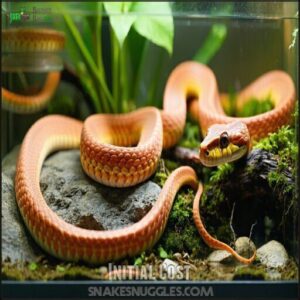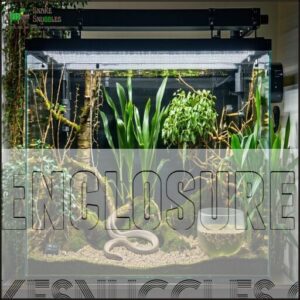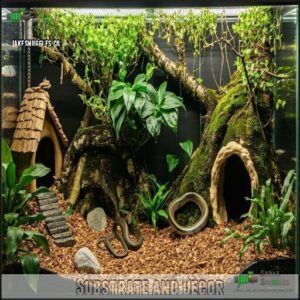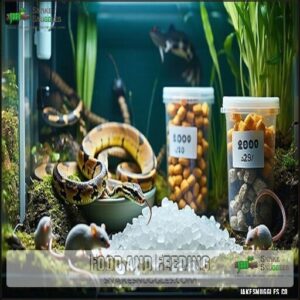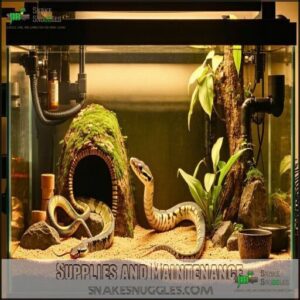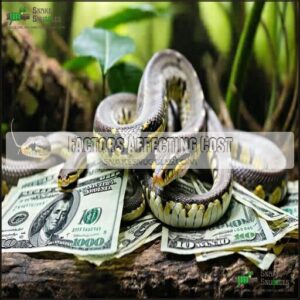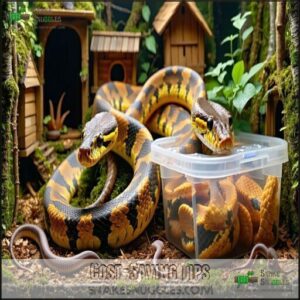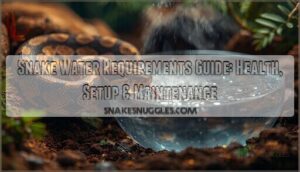This site is supported by our readers. We may earn a commission, at no cost to you, if you purchase through links.

Beyond the snake itself, you’ll need to budget $150-$300 for a proper setup including tank, heating, substrate, and hides.
Don’t forget ongoing costs—feeding your scaly friend will run about $10-$15 monthly for frozen mice.
Veterinary checkups might cost $50-$100 annually, while corn snakes won’t break the bank like some exotic pets, remember that the cheapest option isn’t always the best value in regards to these low-maintenance companions.
Table Of Contents
- Key Takeaways
- How Much Does a Corn Snake Cost?
- Initial Cost
- Housing and Setup
- Ongoing Expenses
- Factors Affecting Cost
- Cost-Saving Tips
- Frequently Asked Questions (FAQs)
- How expensive is owning a snake?
- How long will a corn snake live?
- How much does it cost to handle a corn snake?
- Does Petco sell corn snakes?
- Are corn snakes cheap?
- How much does a corn snake morph cost?
- How much does a corn snake enclosure cost?
- How much does a baby corn snake cost?
- How much does a corn snake cost in Georgia?
- Why are corn snakes so expensive?
- Conclusion
Key Takeaways
- You’ll typically pay $30-$200 for a corn snake, with common morphs around $50 and rare varieties exceeding $500 depending on their genetic traits and coloration.
- Your initial setup costs will range from $150-$300 for essential equipment like a proper enclosure, heating elements, substrate, and hides to create a suitable habitat.
- You’ll need to budget $10-$20 monthly for ongoing expenses, primarily for frozen mice feeders, substrate replacements, and annual vet checkups that cost $50-$100.
- You can save money by considering DIY enclosures, buying supplies in bulk, or adopting from rescue centers where fees typically range from free to $25 and often include basic supplies.
How Much Does a Corn Snake Cost?
The cost of a corn snake typically ranges from $30 to $200, depending on factors like age, rarity, and patterns.
Standard snake morphs cost around $50, while rare varieties can surpass $500.
If you’re starting your Corn Snake Budget, expect to pay more for unique colors or premium breeders.
On average, $50-$150 secures a healthy, well-bred pet.
Understanding cost factors, such as morphs and breeder quality, helps guarantee you bring home the perfect snake.
Initial Cost
When buying a corn snake, you’ll find prices range between $30 and over $1,000, depending on factors like age, morph, and rarity.
Hatchlings and common color patterns are more affordable, while adults and unique morphs can cost substantially more, often due to their rarity.
Hatchling Prices
If you’re eyeing a new baby corn snake, prices in 2025 vary based on morphs and genetic traits.
A basic hatchling corn snake price falls between $30-$50, offering an affordable entry point for reptile enthusiasts. Uncommon morph prices like Hypo or Albino are higher, ranging from $60-$100, while rare patterns such as Cherry Amel Tessera can exceed $600.
These hatchling fees often vary by breeder and season, affecting the corn snake price range.
- Breeder Fees: Reliable breeders guarantee captive-bred, healthy snakes.
- Morph Prices: Unique patterns cost more; research what fits your budget.
- Starter Kits: Affordable setups help manage your initial investment.
Researching options guarantees a perfect fit for your lifestyle. Understanding the initial setup costs is vital for planning.
Adult Prices
Adult corn snakes usually fall within a purchase fee range of $50-$150.
Younger adults (1-2 years old) tend to cost less, starting around $50, while mature adults (3-5 years) often range closer to $100. Senior adults (6+ years) may be pricier due to their established temperament and feeding routine.
The adult corn snake price varies based on size, age, and health. Price factors, like snake morphs and rare color variations, also affect the corn snake cost, making the corn snake price range diverse.
Morph Varieties
Corn snake morphs offer breathtaking color patterns shaped by selective breeding techniques.
Common morphs like Albino cost $40-$50, while rare varieties like Scaleless surpass $500.
Genetic traits influence prices, with compound morphs combining unique features for $1,000 and up.
Research morphs like Palmetto ($350+) to find the perfect balance between budget and beauty when planning your corn snake’s price.
Understanding corn snake genetics is essential for making informed decisions about the type of morph to purchase, considering corn snake and genetic traits.
Housing and Setup
Setting up the right home for your corn snake is essential and can cost between $50 and $300, depending on the materials and equipment you choose.
You’ll need an appropriately sized tank, secure lid, proper heating, safe substrate, and a few hides to create a comfortable and safe environment.
Enclosure
Choosing the perfect corn snake habitat guarantees your pet’s comfort and safety.
A 20-gallon tank, a popular choice for juveniles, runs $75-$150, but adults thrive better in a spacious 40-gallon enclosure.
Look for front-opening terrariums with sturdy enclosure materials for durability and secure ventilation systems to maintain air quality.
When setting up the enclosure, consider the importance of proper snake enclosure design(corn snake enclosure) to create a suitable environment.
Add these essentials for a functional setup:
- Escape-proof mesh lid with clips ($15-$30).
- Snake hiding places like 2 hides, plus branches for climbing ($40-$60).
- Large water bowl for humidity control.
Heating and Lighting
Heating and lighting are key to your snake’s health. Expect lighting costs and heating equipment to run $75–$150 depending on your setup.
Create the perfect environment using:
- Heat lamps ($30–$40) for an 85–90°F basking zone.
- An under-tank heat mat ($20–$30) to keep ambient snake temperature at 70–75°F.
- UVB lighting ($25–$35) to support vitamin D3 and overall snake heating needs.
- A thermostat and thermometer ($35–$45) for temperature control and safety.
Pair these with proper humidity levels and regular thermostat checks for ideal care. Understanding proper snake heating is essential for creating a suitable environment.
Substrate and Decor
A good snake substrate like coconut fiber or cypress mulch helps control humidity and keeps your corn snake comfortable.
Add snake decorations, such as artificial plants, branches, and decorative rocks, to create a natural vibe.
Don’t forget snake hides or burrowing areas for enrichment—your pet will thank you!
Clean the substrate regularly to maintain hygiene and spot-clean weekly.
Place decor strategically to allow easy movement and resting spots, ensuring your snake feels safe and at home.
Choosing the right snake substrate options is essential for a healthy environment.
Ongoing Expenses
Caring for a corn snake means budgeting for ongoing expenses like food, bedding, and occasional healthcare.
These costs typically range from $30 to $50 per month, depending on the supplies and care your snake needs.
Food and Feeding
Feeding your corn snake requires careful budgeting for ongoing expenses.
Here’s what you’ll pay for snake nutrition:
- Adult corn snakes eat 1-2 feeder mice weekly, costing $10-$20 monthly
- Baby snakes need smaller "fuzzy" mice at about $1 each
- Frozen mice cost slightly over $1 each when bought in bulk
- Most owners spend $2-$4 weekly on prey items
- Feeding frequency varies: hatchlings eat every 5-7 days, adults need only 3 meals monthly
Always purchase from reputable suppliers and choose frozen prey for safety.
Bulk purchasing saves money and guarantees you’ll have food when needed, which is important for ongoing expenses and to ensure the snake’s nutritional needs are met with the right prey items.
Veterinary Care
Beyond feeding your corn snake, you’ll need to budget for veterinary care.
Annual health checks cost $50-$100, while parasite tests run $10-$30.
Emergency care can hit your wallet hard at $500-$1000.
Though pet insurance for reptiles isn’t common, setting aside money for unexpected vet visits is smart.
Finding a vet with reptile experience matters – they’ll spot issues like respiratory infections or mouth rot early.
Supplies and Maintenance
Beyond vet visits, your corn snake needs regular supplies that add to your monthly budget.
Regular tank maintenance keeps your pet healthy and saves money in the long run.
- Substrate replacement: $10-$30 monthly for fresh bedding
- Cleaning supplies: $5-$10 monthly for safe reptile disinfectants
- Feeding tools: $15-$20 for quality tongs (replace yearly)
- Humidity control items: $10-$20 for moss or spray bottles
- Tank accessories: $0-$20 for replacing worn hides or branches
Your snake tank cost isn’t just a one-time expense.
Keep $30-$50 in your monthly budget for these reptile supplies.
Snake habitat maintenance is straightforward but consistent.
Remember to check heating costs regularly too—a broken heat mat could mean an emergency replacement when you least expect it.
Proper snake enclosure setup is essential for maintaining a healthy environment for your pet.
Factors Affecting Cost
You’ll pay different prices for your corn snake depending on where you buy it and what it looks like.
Buying from breeders instead of pet stores, shopping online versus locally, and choosing rare color patterns (morphs) can change your costs.
From as little as $30 to over $1,000, these factors can significantly impact the final price of your corn snake, making rare color patterns a key consideration in your purchase decision.
Breeder Vs Pet Store
When choosing where to buy your corn snake, the source matters for both your wallet and the snake’s wellbeing.
Breeders typically offer healthier snakes with known histories and better temperaments. You’ll pay $50-$150 for quality, but gain peace of mind about breeding standards and snake origin.
Pet stores provide convenience but often sell snakes with unknown backgrounds at similar prices. The reptile ethics can be questionable, with potential health issues down the line.
Your corn snake price reflects this trade-off.
Online Vs Local Purchase
When deciding between online and local corn snake purchases, consider what matters most to you – variety or convenience.
Online retailers offer:
- Access to hard-to-find morphs that local shops simply don’t carry
- The ability to compare corn snake prices across multiple sellers
- Detailed online reviews from previous customers to verify seller reputation
Local breeders provide hands-on advantages, though. You’ll avoid shipping costs (typically $30-$50) and can inspect your snake before buying. Many local breeders offer post-purchase support that’s more personal than online stores.
For safety, only purchase from sellers with positive reviews and clear health guarantees. If buying online, verify the seller’s delivery options and shipping protocols for reptiles.
Remember that shipping stress can affect snakes, so ask about acclimation procedures. Local purchases eliminate this concern entirely while supporting businesses in your community. Reputable breeders prioritize healthy snake practices to guarantee the well-being of their animals.
Rare or Unique Morphs
Many rare corn snake morphs can cost over $1,000 due to their unique genetic traits.
Countless rare corn snake morphs can fetch premium prices, sometimes exceeding $1,000 for the most unique specimens.
When shopping for these special specimens, three key factors drive up prices:
- Color genetics – Uncommon patterns like Tessera morphs cost $250+
- Breeding complexity – Compound morphs combining multiple traits cost more
- Snake rarity – Albino corn snakes range $80-$150 while common morphs stay at $30-$50
Cost-Saving Tips
You can keep corn snake ownership affordable by getting creative with DIY enclosures, buying supplies in bulk, and considering adoption from rescue centers.
Getting a secondhand tank and making your own hide boxes can save you $100+ on setup costs, while purchasing frozen mice in bulk packs can cut your monthly feeding expenses in half, which is a significant factor in maintaining affordable ownership.
DIY Enclosures
You can save significant money by building your own corn snake enclosure instead of buying pre-made tanks.
A basic DIY snake habitat using wood, plastic, or repurposed furniture typically costs $20-40, compared to $75-300 for commercial setups.
Focus on proper ventilation systems using mesh screens ($5-10) and secure lids to prevent escapes.
Create custom hide boxes from plastic containers or small wooden boxes ($0-5) and add climbing structures from sanitized branches ($0).
The key requirements are smooth surfaces (no splinters), non-toxic materials, and proper sizing (20-gallon equivalent for adults).
Simple tank designs can be completed in a weekend with basic woodworking skills.
When planning your DIY project, consider snake enclosure materials to guarantee a safe and healthy environment for your pet.
Bulk Buying Supplies
Buying supplies in bulk offers significant cost savings for corn snake owners.
You can stretch your dollar by ordering frozen mice in large quantities, typically saving 30-40% compared to individual purchases.
Pet supply websites often provide discount codes for first-time orders.
Consider joining snake owner forums where members organize group purchases for substrates and accessories at wholesale prices.
Many online retailers offer free shipping when you reach minimum order thresholds, making bulk ordering even more economical.
Adopting or Rescuing
I’ll create improved content about adopting or rescuing corn snakes as a cost-saving option.
A compassionate corn snake awaits you at local rescue centers, often at a fraction of pet store prices.
Adoption fees typically range from free to $25, making this the most budget-friendly option for new snake owners.
- Rescue organizations provide already-rehabilitated snakes with health checks included
- Foster care programs let you "test drive" snake ownership with zero financial commitment
- Many sanctuaries offer complete care kits with adopted snakes, saving $50-$100 on setup
- Volunteering with reptile rescues can lead to free adoption opportunities
- Rehoming from previous owners often includes enclosures and supplies at no extra cost
Most adoption processes include health screenings, necessary treatments, and a quarantine period before you bring your new pet home.
Frequently Asked Questions (FAQs)
How expensive is owning a snake?
The initial cost for a snake ranges from $30-$200+, plus $100-$300 for setup.
You’ll spend about $20-$50 monthly on food and bedding, with occasional vet bills of $50-$
Consider their 15-20 year lifespan.
How long will a corn snake live?
Your corn snake will likely live 15-20 years with proper care. They’re long-term companions that’ll be with you through many life changes, so be prepared for this significant commitment.
How much does it cost to handle a corn snake?
Handling a corn snake won’t cost you a dime!
Once you’ve purchased your snake ($30-$200+), the actual handling requires nothing but your time and gentle hands.
Regular handling improves their temperament.
Does Petco sell corn snakes?
Yes, Petco does sell corn snakes at their Pet Care Centers. You’ll want to call ahead to check availability before visiting as their reptile inventory can vary between locations.
Are corn snakes cheap?
Like a gentle breeze on your wallet, corn snakes are relatively affordable pets. You’ll spend $30-$50 for a common morph, while enclosure setup adds $50-$100 and monthly costs run $10-$
How much does a corn snake morph cost?
Morph prices vary widely. You’ll pay $30-$50 for common morphs, $80-$700 for popular varieties, and over $1,000 for rare combinations. Rarity and breeding difficulty directly impact what you’ll spend.
How much does a corn snake enclosure cost?
A basic corn snake enclosure costs $30-50 for a 20-gallon tank, while a complete setup with accessories runs $50- You’ll need a larger 40-gallon tank ($300) as your snake grows.
How much does a baby corn snake cost?
A penny saved is a penny earned when shopping for baby corn snakes. You’ll typically pay $30-$50 for standard patterns, while specialty morphs can cost $80-$700 depending on rarity.
How much does a corn snake cost in Georgia?
In Georgia, you’ll find corn snakes priced between $30-$200 depending on morph type. Common varieties cost $50-70 at pet stores, while specialty morphs from breeders run $100+.
Why are corn snakes so expensive?
Corn snakes aren’t inherently expensive, but specialty morphs with unique color patterns can cost hundreds due to selective breeding.
You’re paying for genetics, breeder expertise, and rarity when prices climb beyond $
Conclusion
Ultimately, determining how much does a corn snake cost boils down to your choices.
Like a financial puzzle with flexible pieces, your investment ranges from $170-$500 initially, plus $15-$25 monthly.
You’ll find bargains through reptile rescues or splurge on dazzling morphs—it’s your call.
Remember, these slithery companions live 15-20 years, so cutting corners isn’t wise.
Weigh your options carefully, prepare your budget thoughtfully, and you’ll enjoy years with your low-maintenance pet.

